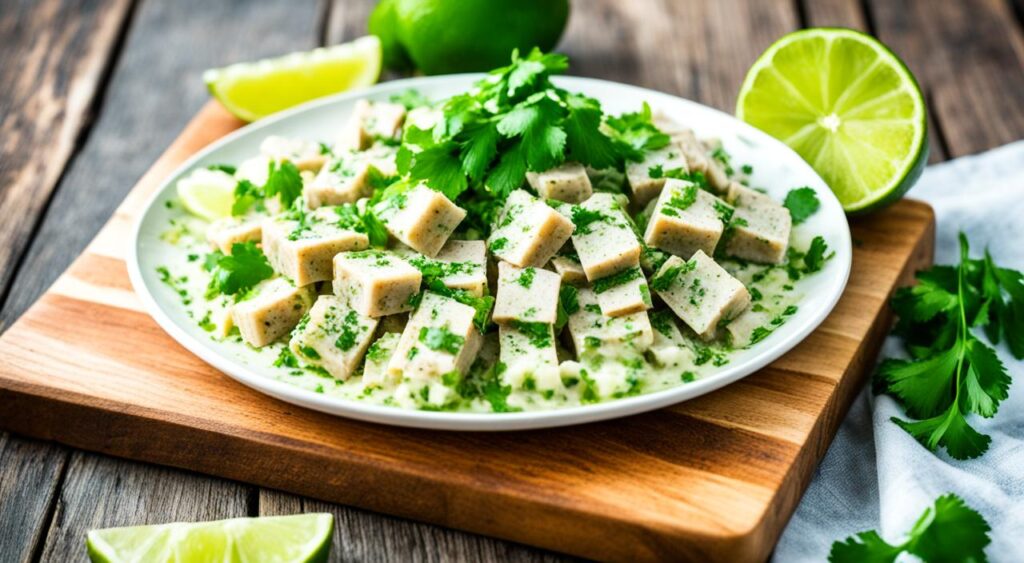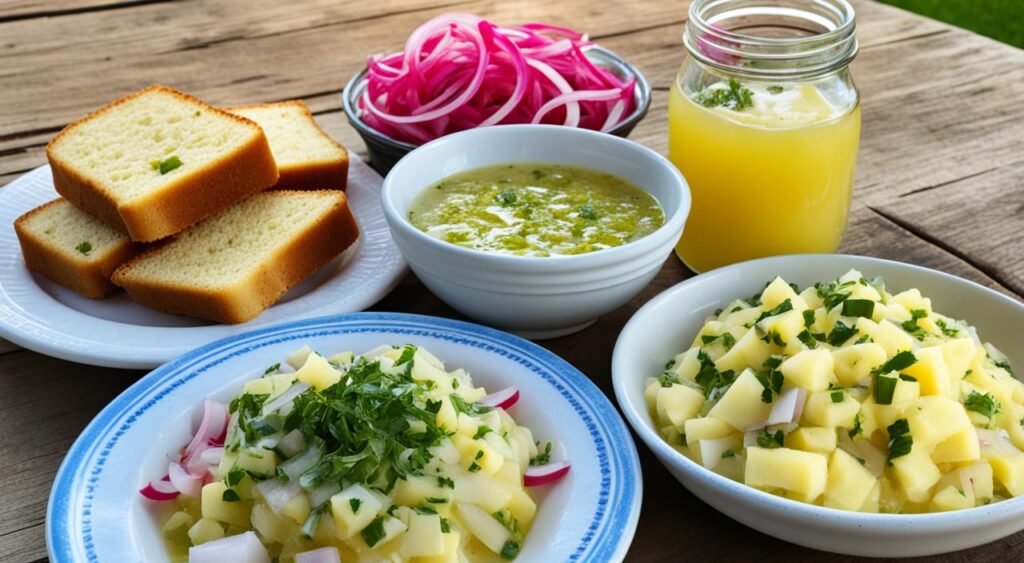Welcome to our guide on how to enjoy souse! Souse is a traditional dish with a unique flavor profile that is popular around the world. Whether you’re a souse enthusiast or new to this culinary delight, this article will provide you with tips and suggestions to make your souse experience even more enjoyable.
In this section, we will cover souse consumption, souse eating etiquette, and souse dish presentation. By the end, you’ll have all the information you need to savor every bite of this delicious dish.
Key Takeaways:
- Learn the proper techniques for consuming souse to fully appreciate its flavors.
- Understand the etiquette associated with eating souse, including utensil use and handling bones or inedible parts.
- Discover different ways to present souse for an aesthetically pleasing dining experience.
- Explore food pairing recommendations to enhance the flavors of souse.
- Embrace souse eating traditions to add cultural significance and enjoyment to your meal.
Understanding Souse: A Brief Introduction

Before delving into the ways souse is eaten, let’s briefly discuss what souse actually is. Souse is a traditional dish that involves cooking various meats, such as pork or beef, in a flavorful broth. It is often served chilled and is popular in many cuisines around the world. Different regions may have their own variations and culinary customs when it comes to preparing souse.
One of the traditional souse dishes is the Caribbean-style Pickled Pig’s Feet. This delicacy consists of tender pig’s feet cooked in a tangy vinegar-based marinade with spices like bay leaves, garlic, and peppercorns. It is usually served cold and is a popular dish during festive occasions in Caribbean cuisine.
In Nordic countries, there is a variation of souse known as sylte. This dish typically features pork or veal cooked in a broth made from vinegar, water, and spices like allspice and cloves. Sylte is often prepared in a large, terrine-style mold and can be served cold or at room temperature with accompaniments like mustard and pickles.
Across different cultures, souse culinary customs vary in terms of the choice of meat, the spices used in the broth, and the overall flavor profile. However, the common thread among all traditional souse dishes is the combination of tender meat cooked in a flavorful and often tangy broth.
Souse Culinary Customs Around the World
Here are some examples of souse culinary customs from different regions:
- In the Caribbean, souse is often enjoyed with a side of freshly baked bread or served alongside other traditional dishes like rice and peas.
- In Germany, souse is commonly paired with sauerkraut and mustard, creating a harmonious balance of flavors.
- In the Philippines, a popular variation of souse called “tokwa’t baboy” combines pork and tofu in a tangy soy-vinegar sauce, often served as a beer match.
- In the United States, specifically in the American South, souse is enjoyed as a breakfast dish with grits and biscuits, providing a hearty start to the day.
“Souse is a versatile dish that showcases the unique flavors and culinary traditions of different cultures. From tangy vinegar-based marinades to spicy broth infusions, souse offers a delightful sensory experience for food enthusiasts around the world.” – Souse Connoisseur Magazine
Souse Serving Suggestions: How to Present It

The presentation of souse plays a crucial role in enhancing your dining experience. Whether you’re hosting a formal dinner party or enjoying souse casually with friends, paying attention to the dish’s visual appeal can elevate the overall enjoyment. Here are some serving suggestions to keep in mind:
Garnishes
Add a touch of freshness and color to your souse by garnishing it with complementary ingredients. Consider using:
- Crisp lettuce leaves
- Sliced radishes
- Chopped fresh herbs like parsley or cilantro
- Lemon or lime wedges for a hint of citrus
Plating Techniques
The way you arrange the souse on the plate can create an enticing visual display. Experiment with different plating techniques such as:
- Stacking the souse neatly in layers
- Arranging the meats and vegetables in an artful manner
- Creating a harmonious balance of colors and textures
Complementary Side Dishes
Pairing souse with well-chosen side dishes can enhance the overall flavor profile and presentation. Consider serving souse with:
- Crusty bread or crackers
- Pickled vegetables for a tangy contrast
- Simple salads with light dressings
Remember, the presentation of souse is an opportunity to showcase your creativity and attention to detail. Experiment with different garnishes, plating techniques, and side dishes to create a visually stunning and appetizing spread.
| Garnishes | Plating Techniques | Complementary Side Dishes |
|---|---|---|
| Crisp lettuce leaves | Stacking the souse neatly in layers | Crusty bread or crackers |
| Sliced radishes | Arranging the meats and vegetables in an artful manner | Pickled vegetables for a tangy contrast |
| Chopped fresh herbs like parsley or cilantro | Creating a harmonious balance of colors and textures | Simple salads with light dressings |
| Lemon or lime wedges for a hint of citrus |
Savoring Every Bite: Souse Eating Etiquette

To fully appreciate and enjoy souse, understanding the proper souse eating etiquette is crucial. The way you consume souse can have an impact on your overall dining experience. In this section, we’ll discuss the dos and don’ts of souse consumption to ensure you savor every bite.
First and foremost, let’s tackle the question of utensils. While there are no strict rules, traditionally, souse is eaten with your hands. Using your fingers allows you to fully engage with the textures and flavors of the dish. However, if you prefer to use utensils, it is perfectly acceptable to do so.
When eating souse, it’s important to be mindful of any bones or inedible parts. Take small bites, chew carefully, and remove any bones or unwanted parts discreetly from your mouth. If you’re unsure about a certain component, it’s best to ask for guidance or observe others around you.
“Eating souse is not just about the food, but also about the company and the moment.”
Another aspect of souse eating etiquette is being aware of cultural customs. Different cultures may have specific traditions associated with the consumption of souse. For example, in some regions, souse is considered a dish to be enjoyed during festive occasions or celebrations. Understanding and respecting these customs adds depth and meaning to your souse dining experience.
“Savoring souse goes beyond the act of eating – it’s about embracing cultural traditions and creating lasting memories.”
Now that we’ve covered the basics of souse eating etiquette, it’s time to indulge in this flavorful dish.
| Dos | Don’ts |
|---|---|
| Eat souse with your hands for a fuller sensory experience. | Don’t criticize or judge others for their souse eating preferences. |
| Chew souse carefully and remove any bones or inedible parts discreetly. | Don’t leave bones or inedible parts on your plate. |
| Respect and embrace cultural traditions associated with souse consumption. | Don’t be afraid to ask for guidance or clarification if unsure about a certain aspect of souse. |
By following these dos and don’ts of souse eating etiquette, you’ll be able to fully savor and appreciate the flavors of this traditional dish. Remember, enjoying souse is not just about the food itself, but also about the company, the cultural traditions, and the memories created.
Pairing Souse: Food Recommendations

Souse, with its distinct flavor profile, can be enhanced by pairing it with complementary foods. Whether you prefer something light and refreshing or a bold and savory accompaniment, here are some food pairing tips to elevate your souse dining experience:
1. Salads
Pair souse with a crisp and refreshing salad to balance out its rich flavors. Opt for a simple green salad with citrus vinaigrette or a tangy coleslaw to provide a contrast to the souse’s tanginess.
2. Pickles
Add some zing to your souse by serving it alongside pickles. The acidity of pickles cuts through the richness of souse and adds a burst of flavor. Try including pickled cucumbers, onions, or jalapenos for a tangy twist.
3. Bread
Enjoy souse on slices of fresh bread for a satisfying combination. The softness of the bread complements the texture of the souse, while the flavors meld together for a delightful bite. Serve it on a baguette, rolls, or even cornbread for a unique twist.
4. Condiments
Experiment with different condiments to enhance the flavors of your souse. Mustard, horseradish, or hot sauce can add a kick of heat, while mayonnaise or aioli can provide a creamy element. Spread or dip your souse in these condiments to explore new flavor combinations.
Remember, the key to successful food pairings is balance and contrast. Choose foods that complement and enhance the flavors of souse without overpowering it.
| Souse | Recommended Pairings |
|---|---|
| Souse made with pork |
|
| Souse made with beef |
|
| Spicy souse |
|
Discover your favorite food pairings for souse and let your taste buds embark on a delicious journey of flavors.
Embracing Souse Eating Traditions

Souse is more than just a dish—it is a cultural tradition that brings people together in celebration. Across different regions, souse is enjoyed in specific ways, often during special occasions or festive gatherings. These time-honored traditions add a layer of significance and enhance the overall enjoyment of the meal.
One cherished souse eating tradition is the making of homemade souse during the holiday season. Families come together to prepare the dish, sharing in the labor and love that goes into its creation. The process becomes a bonding experience, with each generation passing down their secret recipes and techniques. This tradition not only ensures the preservation of family food culture but also creates lasting memories.
Another souse eating tradition is the communal aspect of its consumption. Souse is often served at social gatherings or community events. It becomes a centerpiece around which people gather, sparking conversations and fostering a sense of togetherness. The act of sharing a souse meal with loved ones or friends strengthens bonds and creates a joyful atmosphere.
Additionally, souse is commonly enjoyed during cultural festivals and religious celebrations. In Trinidad and Tobago, for example, souse is a staple at Carnival, a vibrant and colorful festival that celebrates Caribbean culture. The lively atmosphere of the festival is amplified by the flavors and aromas of souse, making it an integral part of the festivities.
“Souse is more than just a dish—it is a cultural tradition that brings people together in celebration.”
To fully embrace souse eating traditions, consider incorporating elements of these customs into your own souse dining experience. Whether it’s preparing souse with loved ones, organizing a souse-themed gathering, or exploring the cultural significance of souse in different regions, these traditions can deepen your appreciation and enjoyment of this beloved dish.
Now that we’ve explored the rich heritage and customs surrounding souse, let’s continue our culinary journey by delving into the art of souse dish presentation.
The Significance of Souse Eating Traditions
- Souse is a dish that brings families together during the holiday season.
- Sharing souse with loved ones strengthens bonds and creates joyful memories.
- Souse is enjoyed during cultural festivals, adding to the celebratory atmosphere.
- Incorporating souse eating traditions enhances the overall dining experience.
Conclusion
In conclusion, souse is a versatile and flavorful dish that can be enjoyed in various ways. Whether you prefer it chilled or at room temperature, souse offers a unique combination of tender meats and a savory broth that tantalize your taste buds.
By understanding souse consumption, eating etiquette, dish presentation, and food pairing recommendations, you can elevate your souse dining experience to new heights. Take the time to learn about the different traditions and cultural significance associated with souse, and incorporate them into your own meals for an added layer of enjoyment.
So why not explore the wonderful world of souse? Try out different recipes, experiment with different side dishes and garnishes, and savor every bite. Whether you’re hosting a special occasion or simply enjoying an evening with friends, souse is sure to be a crowd-pleaser that leaves a lasting impression. So go ahead, embrace the flavors and traditions of souse, and elevate your dining experience today!

